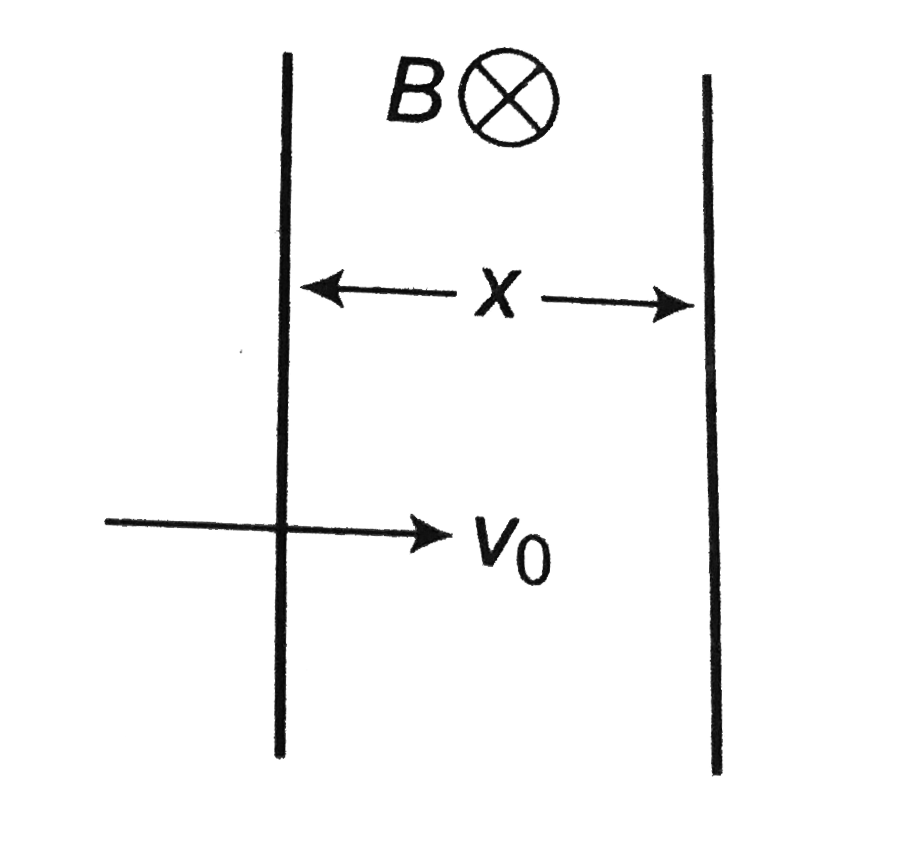When E↑↑Be and particle velocity is perpendicuular to both of these field.
Consider a particel of charge q and mass m released from the origin with velocity v=v0ˆi into a region of uniform electric and magnetic fields parallel to y-axis i.e. E=E0ˆj and B=B0ˆj. The electric field accelerates the particle in y-direction i.e. y-component of velocity goes on increasing with acceleration
ay=Fym=Fem=qE0m .........i
The magnetic field rotates the particle in a circle in xy-plane (perpendicular to magnetic field). The resultant path of the particle is a helix with increasing pitch. The axis of the plans is parallell to y-axis. Velocity of the particle at time t would be
v(t)=vxˆi+vyˆj+vzˆk
Here,vy=aytqE0mt
and v2x+v2z=constant=v20
θ=ωt=Bqmt
vx=v0cosθ=v0cos(Bqt)m
and vz=v0sinθ=v0sin(Bqtm)
∴v(t)=v0cos(Bqtm)ˆi+(qE0mt)ˆj+v0sin(Bqtm)ˆk
Similarly, position vector of particle at time t can be given by
r(t)=xˆi+yˆj+zˆk
Here y=12nayt2=12(qE0m)t2
x=rsinθ=(mv0Bq)sin(Bqtm)
and z=(1−cosθ)=(mv0Bq)[{1−cos(Bqtm)}]
∴r(t)−(mv0Bq)sin(Bqtm)ˆi+12(qE0m)t2ˆj+(mv0Bq)[{1−cos(Bqtm)}]ˆk

Topper's Solved these Questions
- BOOK - DC PANDEYCHAPTER - MAGNETICSEXERCISE - Exercise160videos
MAGNETICS
- BOOK - DC PANDEYCHAPTER - MAGNETICSEXERCISE - INTRODUCTORY EXERCISE1videos
MAGNETICS
- BOOK - DC PANDEYCHAPTER - MAGNETIC FIELD AND FORCESEXERCISE - Medical entrance s gallery59videos
MAGNETIC FIELD AND FORCES
- BOOK - DC PANDEYCHAPTER - MAGNETISM AND MATTEREXERCISE - Medical gallery1videos
MAGNETISM AND MATTER
Similar Questions
A charged particle enters a uniform magnetic field with velocity v0=4m/s perpendicular to it, the length of magnetic field is x=(√32)R, where R is the radius of the circular path of the particle in the field. Find the magnitude of charge in velocity (in m/s) of the particle when it comes out of the field.
View SolutionWhich of the following particles will describe the smallest circle when projected with the same velocity perpendicular to the magnetic field ?
View Solution
Knowledge Check
- Question 1 - Select One
When a charged particle moves perpendicular to a magnetic field, then:
Aspeed of the particle is changedBspeed of the particle remains unchangedCdirection of the particle remains unchangedDacceleration of the particle remains unchanged - Question 2 - Select One
When a charged particle moves perpendicular to a magnetic field, then:
Aspeed of the particles is changedBspeed of the particle remains unchangedCdirection of motion of the particle remains unchangedDacceleration of the particle remains unchanged - Question 3 - Select One
Assertion When a charged particle moves perpendicular to a uniform magnetic field then its momentum remains constant.
Reason Magnetic force acts perpendicular to the velocity of the particle.AIf both Assertion and Reason are true and Reason is the correct explanation of Assertion.BIf both Assertion and Reason are true but Reason is not correct explanation of Assertion.CIf Assertion is true but Reason is false.DIf Assertion is false but Reason is true.
Which of the following particles will describe the smallest circle when projected with the same velocity perpendicular to the magnetic field ?
View SolutionAn (α)-particle and a proton are both simultaneously projected in opposite direction into a region of constant magnetic field perpendicular to the direction of the field. After some time it is found that the velocity of the (α)-particle has changed in a direction by 45∘. Then at this time, the angle between velocity vectors of (α)-particle and proton is
View SolutionA charged particle enters into a uniform magnetic field with velocity v0 perpendicular to it , the length of magnetic field is x=√32R, where R is the radius of the circular path of the particle in the field .The magnitude of change in velocity of the particle when it comes out of the field is
 View Solution
View SolutionA velocity selector, (a region of perpendicular electric and magnetic field)
Allows charged particles to pass straight when v=E/B
II. Deflects particles in a direction perpendicular to both v and B, whenu>E/B
III. Deflects particles in the direction of electric field whenv<E/B
IV. Deflects all particles in a direction perpendicular to both E and B.View SolutionWhen a charged particle moving with velocity →V is subjected to a magnetic field of induction →B the force on it is non-zero. This implies that:
View Solution

